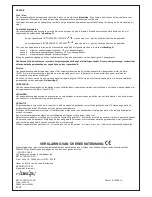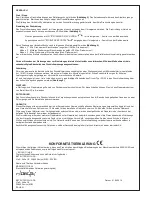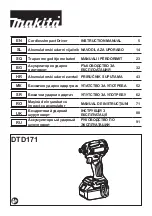
AIR IMPACT WRENCH USE AND CARE
–
Use clamping devices or a vice to secure and support the workpiece. Holding the workpiece by hand or against your body will not
allow for safe operation of the pneumatic tool.
–
Do not overload the pneumatic tool. Use the pneumatic tool intended for your work only.
–
Always check that the machine is free from defects. Do not use a pneumatic tool that has a defective On/Off switch. A pneumatic
tool that can no longer be stopped or started is dangerous and must be repaired.
–
Make any adjustments while the air angle impact wrench is not working. Always disconnect the air supply when not in use. This
safety measure prevents accidental starting of the pneumatic tool.
–
Store idle pneumatic tools out of the reach of children. Do not allow persons unfamiliar with these instructions to operate the
pneumatic tool.
–
Maintain the pneumatic tool with care. Check for misalignment or binding of moving parts, breakage of parts and any other
condition that may affect the operation of the pneumatic tool. Have damaged parts repaired before using the pneumatic tool.
–
Always use impact sockets in good condition.
–
Do not modify the pneumatic tool. This can reduce the effectiveness of safety measures and increase operator risk.
–
Have the pneumatic tool repaired only through a qualified repair person and only using original replacement parts.
AIR IMPACT WRENCH SAFETY
–
Make sure that the nameplate is readable; get a replacement nameplate from the manufacturer, if need be.
–
While the impact wrench is being used, any accidental breakages of individual accessories may cause pieces to be thrown at high
speed.
–
Operators and maintenance personnel should be physically able to handle the weight and power of the pneumatic tool.
–
It is important to be prepared for unexpected movements of the air impact wrench resulting from a jammed or broken work tool.
Maintain a firm grip on the pneumatic tool and position your body and arms to allow you to resist such movements. These
precautions can prevent injuries.
–
Avoid contact with any moving parts of the tool, since these can cause injuries.
–
Make sure that the direction of rotation of the air impact wrench is fit for use.
–
Turn off the tool in case of air supply failure or low operating pressure. Check the operating pressure; turn on the tool again when
optimal operating pressure is resumed.
–
When using the pneumatic tool, the operator can experience discomfort in the hands, arms, shoulders, or neck area. Adopt a
comfortable position and avoid awkward postures. Changing one’s posture may help avoid discomfort and fatigue.
Caution: If the pneumatic tool is used over a protracted period of time, part of the tool and the socket may become hot. Wear
protective gloves.
Using the pneumatic tool on the workpiece generates noise, which may prove harmful to the exposed personnel. A proper
phonometric survey is required to determine the personal hearing protective equipment (hearing protection) to use.
If a specially conducted survey suggests that the daily exposure to vibration generated from the pneumatic tool exceeds the limit
value under the regulations in force in the respective country, anti-vibration gloves must be worn.
–
If you notice that the skin of your fingers becomes numb, turns white, tingles or hurts, stop working with the pneumatic tool, inform
your employer and seek medical advice.
–
Hold the pneumatic tool with a not too firm yet secure grip, compliant with the required hand reaction forces.
–
Never carry the pneumatic tool by the hose.









































